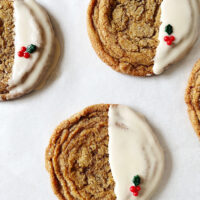
Pan-banging Ginger Molasses Cookies
Perfectly spiced, ginger molasses cookies with rippled edges and a chewy center. Uses the pan-banging cookie technique to get their famous look!
Servings 10 large cookies
Equipment
Ingredients
- 1 3/4 cup (249g) all-purpose flour
- 1/2 teaspoon baking soda
- 1/2 teaspoon + 1/8 teaspoon salt
- 2 teaspoons ground ginger
- 3/4 teaspoon ground cinnamon
- Pinch cloves
- 12 tablespoons (170 grams) unsalted butter, room temperature
- 1 1/2 cup (297g) granulated sugar, plus more for rolling
- 2 tablespoons mild molasses
- 1 egg
- 1 teaspoon pure vanilla extract
- Rum-Butter Glaze for optional holiday variation, recipe in notes
- Holly sprinkles, for optional holiday variation
Instructions
- Adjust an oven rack to the middle position. Preheat the oven to 350°F. Line 3 baking sheets with parchment paper.
- In a small bowl, whisk the flour, baking soda, salt, ginger, cinnamon, and cloves.
- In the bowl of a stand mixer fitted with a paddle, beat the butter on medium until creamy. Add the granulated sugar and beat on medium until light and fluffy, 2 to 3 minutes. Add the molasses, egg, and vanilla, and mix on low to combine. Add the flour mixture and mix on low until combined. Remove the bowl from the stand mixer, and using a spatula, make sure the molasses is completely combined into the dough and that the dough is a uniform color.
- Form the dough into 2-ounce balls (I use this cookie scoop). Roll the balls in granulated sugar to coat. Place 4 balls an equal distance apart on a prepared pan.
- Place the baking sheet in the oven and bake 8 minutes, until the cookies are puffed slightly in the center. Lift the side of the baking sheet up about 4 inches and gently let it drop down against the oven rack, so the edges of the cookies set and the inside falls back down (this will feel wrong, but trust me). After the cookies puff up again in about 2 minutes, repeat lifting and dropping the pan. Repeat 3-4 more times to create ridges around the edge of the cookie. Bake 13 to 16 minutes total, until the cookies have spread out and the edges are golden brown but the centers are much lighter and not fully cooked.
- Transfer the baking sheet to a wire rack; let cool completely before removing the cookies from the pan.
Notes
*Make sure your cookie batter is completely combined - molasses likes to hang out on the sides of the bowl and streak in the dough, so use a spatula at the end and make sure the batter is uniform.
*You don't have to roll them in sugar, but I prefer them that way.
*You can play around with the spices if you want. I only like the teensiest bit of cloves, but you could add a bit more if you like.
*These cookies are rather large, but to get the edges to spread out and crinkle, they need to be on the big side. If you want to make the cookies smaller, you won’t get as many ridges on the outer layer, and your center won’t be quite as gooey. They will still be delicious, but not quite what I intended for you.
*There is a minimal amount of molasses in these cookies, but adding more makes them really chewy and a little tough.
*Throughout my recipes posted on this website, 1 cup of flour equals 142g. Please note that 1 cup of flour can range anywhere from 120g to 142g, depending on the baker or website. I found that after weighting many cups of flour and averaging the total, mine always ended up around this number. If I am posting a recipe from another cookbook, I will use whatever gram measure of flour used in that book, which is why you may see a few posts with a different cup measurement. Different brands of flour have varying levels of protein, ranging from low to high, which can result in very different outcomes when baking. I’ve found Gold Medal all-purpose unbleached flour to be the best option for many of my recipes; I use it in all the baked goods that don’t use yeast. For yeasted doughs that call for all-purpose flour, I like to use King Arthur Brand. If you are using White Lily flour, please note that it is a low protein flour and doesn’t absorb liquid the same as regular all-purpose flours. Check the back of the flour bag for instructions on substituting it for regular all-purpose flours.
*I think they keep best in the fridge, but I like to eat them at room temperature.
Rum-Butter Glaze Recipe, inspired by the recipe and used with permission from the cookbook, Sweet,:
- 1 tablespoon unsalted butter
- Pinch of salt
- 1 to 2 tablespoons black strap rum or dark rum (see note)
- 1/8 teaspoon ground cinnamon (optional)
- 1 ½ cup [180 g] confectioners’ sugar
- Water, as needed